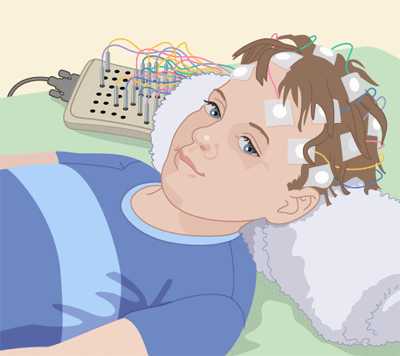EEG (Electroencephalogram)
What It Is
An electroencephalogram (EEG) is a test used to find problems related to electrical activity of the brain.
An EEG tracks and records brain wave patterns. Small metal discs with thin wires (electrodes) are placed on the scalp, and then send signals to a computer to record the results. Normal electrical activity in the brain makes a recognizable pattern. Through an EEG, doctors can look for abnormal patterns that indicate seizures and other problems.
Why It's Done
Most EEGs are done to diagnose and monitor seizure disorders. EEGs also can identify causes of other problems, such as sleep disorders and changes in behavior. They're sometimes used to evaluate brain activity after a severe head injury or before a heart transplant or liver transplant.
Preparation
If your child is having an EEG, preparation is minimal. Your child's hair should be clean and free of oils, sprays, and conditioner to help the electrodes stick to the scalp.
Your doctor may recommend that your child stop taking certain medicines before the test. It's often recommended that kids not have caffeine up to 8 hours before the test. If it's necessary for your child to sleep during the EEG, the doctor will suggest ways to help make this easier.
The Procedure
An EEG can be done in the doctor's office, a lab, or a hospital. Your child will be asked to lie on a bed or sit in a chair. The EEG technician will attach electrodes to different locations on the scalp using adhesive paste. Each electrode is connected to an amplifier and EEG recording machine.
The electrical signals from the brain are converted into wavy lines on a computer screen. Your child will be asked to lie still because movement can change the results.
If the goal of the EEG is to mimic or cause the problem your child is having (like seizures), he or she may be asked to look at a bright flickering light or breathe a certain way. The health care provider performing the EEG will know your child's medical history and will be ready for any issues that could come up during the test.
Most EEGs take about an hour. If your child needs to sleep during it, the test will take longer. You might be able to stay in the room with your child, or you can step outside to a waiting area.
What to Expect
An EEG isn't uncomfortable, and patients do not feel any shocks on the scalp or elsewhere. Still, having electrodes pasted to the scalp can be a little stressful for kids, as can lying still during the test.

Getting the Results
A neurologist (a doctor trained in nervous system disorders) will read and interpret the results. Though EEGs vary in complexity and duration, results usually are available in a few days.
Risks
EEGs are very safe. If your child has a seizure disorder, your doctor might want to stimulate and record a seizure during the EEG. A seizure can be triggered by flashing lights or a change in breathing pattern.
Helping Your Child
You can help prepare your child for an EEG by explaining that it won't be uncomfortable. You can describe the room and the equipment that will be used, and reassure your child that you'll be right there for support. For older kids, be sure to explain the importance of keeping still while the EEG is done so it won't have to be repeated.
If You Have Questions
If you have questions about the EEG procedure, speak with your doctor. You can also talk to the EEG technician before the exam.
